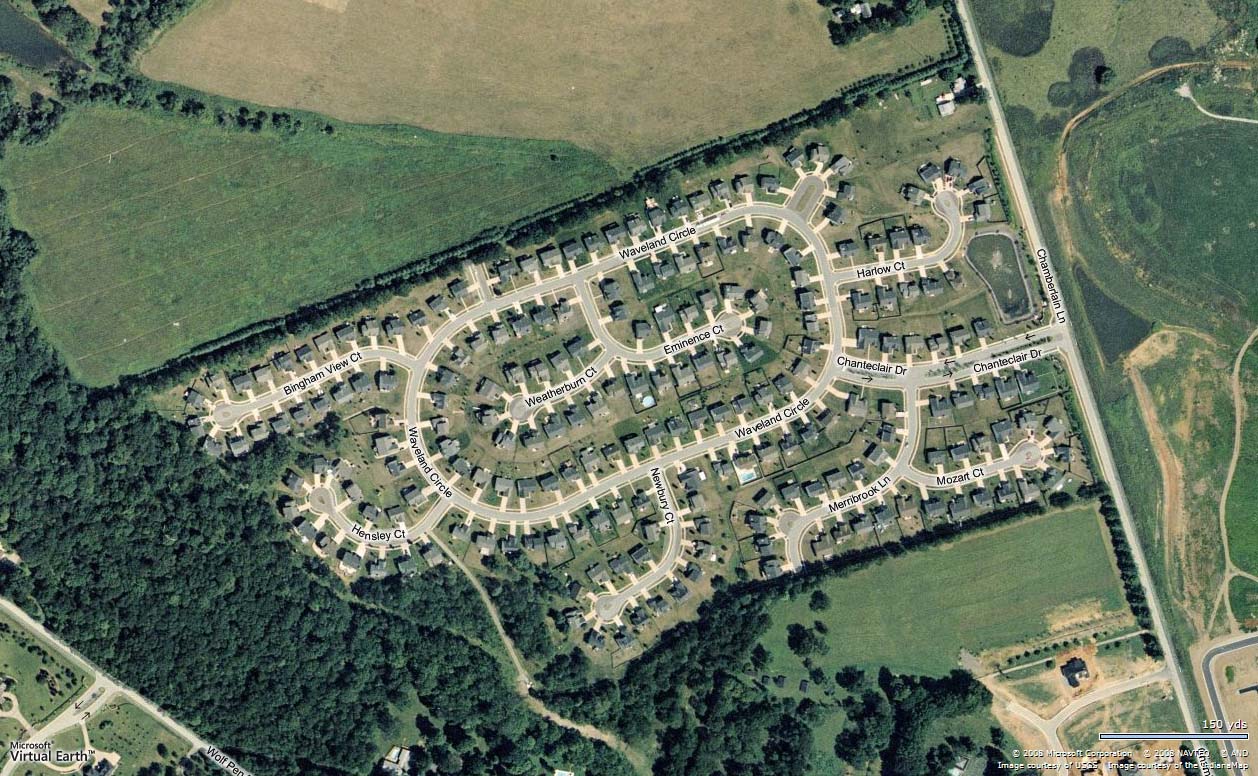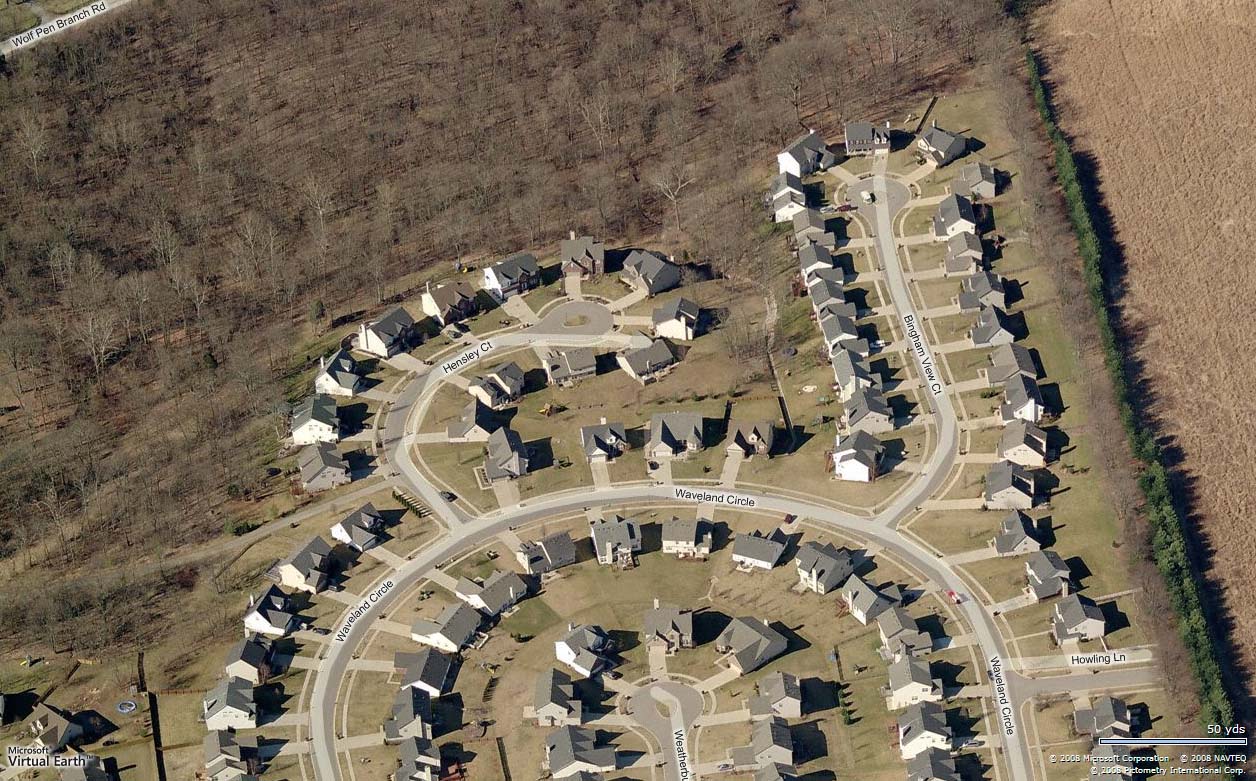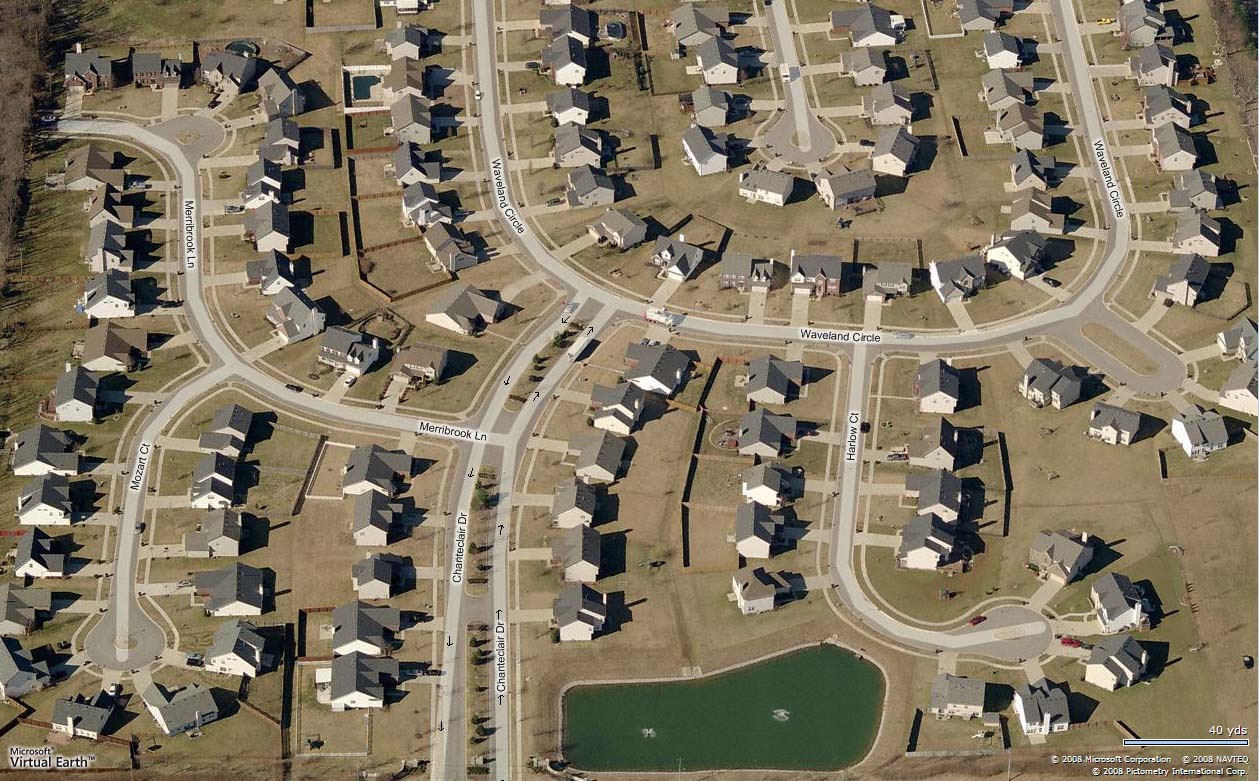A new book looks at the way a California megachurch reflects its landscape.
Sacred Subdivisions: The Postsuburban Transformation of American Evangelicalism
Justin Wilford (NYU Press, November 2012, 233 pp.)
By Fred Folmer
When someone says “suburb,” what comes to mind? Identical split-level houses? Cul-de-sacs? Impeccably groomed lawns? Big box stores? Malls? Automobiles as far as the eye can see? Malaise and alienation? For many, it’s probably some combination of all of the above. It’s also likely that many observers of religion would place “megachurches” or other large houses of worship among the images that indelibly describe suburban life. In fact, the two seem to have gone together from the beginning; in an important sense, large evangelical churches have helped to define the very parameters and fabric of American suburban life.
And although a number of historians of American religion have chronicled this trend, questions remain concerning the specific nature of the entanglement of these respective forms of religious and spatial life. How, for instance, do suburban spatial arrangements themselves help to shape belief and practice? In what ways have the two elements actually constituted one another? Further, as suburbs have pushed farther and farther away from urban centers and become “exurbs,” how has this movement helped to shape evangelical religious personhood (and/or vice versa)?
Such intriguing issues are at the heart of Justin G. Wilford’s Sacred Subdivisions: The Postsuburban Transformation of American Evangelicalism (NYU Press, 2012). Wilford uses the tools of cultural geography to argue that large churches—which he calls “postdenominational”—have, in this “exurban” or “postsuburban” moment, helped to upend the usual urban/suburban binary of center and periphery. Instead, he argues, there is a situation of spatial and, concomitantly, social and religious fragmentation in which people must “make meaning” in variegated, private settings that are highly differentiated in terms of their usage and function. To describe this scenario, Wilford deploys the image of an archipelago, describing small islands of locally articulated “sacred” spaces amid a secularized landscape. Such “sacred” settings might include small groups and niche ministries of the church, along with countless spaces that are frequently taken to be “secular,” such as workplaces or shopping venues.
As such, Wilford argues, adherents of megachurches become “free agents.” “The localized places of everyday life,” he writes, “are left open for sacralization in countless ways, as evidenced by the ever-increasing offerings at evangelical megachurches for evermore finely tuned demographic niches.” In this situation, the church space—the traditional “public” center of religious life—actually functions as a periphery, whereas small groups that meet in private, individualized spaces are now, in postsurburbia, the figurative center. Such an inversion echoes the postsuburban evolution of spatial life: In a suburban setting, a city had retained its place as a “center,” but in postsurburbia, the center has largely evaporated, with private homes and self-defined experiences taking the city’s place as focal points of the lives of individuals. Sacred Subdivisions, then, seeks to describe a highly fragmented spatial, social and religious situation in which there’s not one public center but potentially millions of private ones.
Wilford’s approach, which takes into serious account the religious implications of this cultural and geographic situation, seems long overdue, particularly given the prominence of megachurches and their significant entanglement with surburbia and postsurburbia. And the book’s central insight—that the postsuburban setting represents a new expansion of the private sphere, an effacement of public “center,” whose nature is at once social, personal, religious and spatial—is striking, original and forcefully argued. That said, one limitation of the book is that while Wilford applies his argument and conclusions to the generalized category of postsuburban evangelical churches, the book is largely a case study of one particular, and famous, example: Rick Warren’s Saddleback Church in southern California. Nonetheless, the geographic trend is clear: Among the largest 50 “postdenominational” evangelical churches, Wilford notes, “all but six are set on the residential fringe of large metropolitan areas.” As Warren grew Saddleback in the exurban swaths surrounding Orange County, California, his strategy took into account the kinds of people who might have found themselves in such a geographic situation, namely “people under transition” and “people under tension”—people, in other words, who were experiencing the kind of social and spatial fragmentation that exists in a postsuburban landscape. Saddleback and other churches responded, Wilford argues, by attempting to find a way to turn the tables on this situation—to “connect these fragments in a way that make the transitions and tensions of postsuburbia not just bearable but meaningful.”
Given Saddleback’s massive growth since its founding, it seems that it has done something right along these lines, at least if “rightness” is measured strictly in numbers. Part of what helped the church to draw in so many people, Wilford argues, has been a strategy that has upended another commonly held assumption about centers and peripheries. While it’s common to speak of contemporary religious life in terms of “seekers,” such a usage typically refers to the individual, not the institution, as the one who is doing the seeking. Wilford suggests that Saddleback has reversed this scenario; by catering to individuals’ tastes, needs and preferences, the church, in effect, becomes the seeker. “It is not a matter of churches presenting their organization to the ‘seeking’ masses,” he writes, “but rather of actively seeking the masses out.”
This insight may press the point about “inversions” a little too hard; after all, if churches are trying to cater to “consumer” tastes, and consumers find the church based on those tastes, aren’t both parties doing at least some seeking, much in the same way consumers and producers in any marketplace seek one another out? Nevertheless, postsuburban megachurches, according to Wilford’s argument, have been more flexible and more receptive to their constituents’ needs and tastes than have their mainline or Catholic brethren, and this flexibility is largely responsible for their enormous growth. At Saddleback, this institutional seeking of the “religious customer” has taken a number of forms, including the development of a vast array of tastes: several alternative rock services, a “Spanish-language adult contemporary service,” an African American gospel service, a service featuring traditional hymns. If this menu seems to echo various spaces of consumption—a mall, perhaps, or a tourist resort that has lots of various dining and activities options—that’s quite literally by design. Wilford notes that Saddleback’s campus is intended to “mirror the architectural design of its surrounding environment,” a landscape well known for the prominence of its shopping spaces and opportunities for consumption. The line between consumption and religion—and, moreover, between what has been “sacralized” and what hasn’t—frankly seems so porous as to be nonexistent.
This is where Wilford’s argument becomes rather problematic, because he implies that there can, indeed, be a demarcation between what is “sacred” and what is not. For instance, his frequently used imagery of “sacred archipelagos” suggests that even though there isn’t one central location of sacredness, there are many places that are “sacred” and others that remain “secular.” Too, in the book’s early chapters Wilford addresses secularization theory extensively, arguing that in spite of the limitations of such theory, its proponents’ articulation of the separation of various social systems—“such as the state, market, institutional education, science, and, most importantly, religion”—into discrete spheres remains quite valid. He makes this argument in contradistinction to other theorists such as the anthropologist Talal Asad, who argues in Formations of the Secular that the delineation of what is “religious” is so frequently untenable that “modern hybrids” (such as the constant entry of “religion” into debates about politics or education) greatly attenuate the boundaries of these various spheres. This renders secularization theory largely null and void. For Asad, calling something “religious” or “secular” is a matter of articulation of power, and not an ontological distinction; further, the “religious” can always creep in, even where it’s been discursively, or legally, shut out.
Wilford’s rejoinder to Asad on this idea—a legalistic argument that discusses the way religion is kept out of public policy debates in favor of secular arguments—frankly misses Asad’s larger point about the ways that the “religious” can’t ever be truly cordoned off from the way persons imagine their social worlds, or their personhood. Moreover, this response demonstrates how wedded he appears to be to the distinctiveness of his categories, an adherence that hampers the effectiveness of his analysis. It is hard not to notice, for instance, that a “sacred” and “secular” distinction seems to become lost as persons engage Saddleback as part of their lives, “consuming” its spaces, its music, its voluminous publishing and recording enterprises—these practices appear to blend seamlessly, just as they were designed, into everyday life worlds of movement, and of buying and consuming and feeling the postsuburban environment. It is therefore hard to see the usefulness of trying to draw lines between sacredness and secularity, or indeed of employing these as terms of analysis at all. And while it’s very likely true that Saddleback attendees may make this distinction themselves, it’s not clear from Wilford’s narrative the terms by which this is happening, or how they go about marking off these boundaries. Rather, Wilford employs words like “sacredness” as if the meaning of such words were self-evident—as if “sacredness” could ever truly be a term of sociological definition, rather than a theological one—even though, let’s remember, that he states that people “sacralize” their environment in “countless ways.” What are these ways? What do these “sacralizations” truly have to do with the postsuburban environment in which they live, worship, work, recreate and consume? In part because Wilford has interpreted the categories of “religious” and “secular” to be more substantive than they are, his book can only take us so far in understanding the answers to these questions.
Wilford offers a somewhat more fruitful analysis as he discusses the way that Saddleback’s public venues actually decrease in importance as people join and become more deeply involved with its ministries. Such movement, as Wilford notes, is as much a spatial trajectory as it is a social one. Although many congregants start by attending one of the central worship services—in a “Worship Center” that holds nearly 3,000 people—as they move “toward a deeper ‘commitment to Christ,’ they move spatially away from the church campus and toward specialized, personal ministries.” These personal ministries take the form of small groups that typically meet in private homes; every group is provided with Saddleback study materials: books, DVDs, audio recordings and so forth. This is where the deepest religious commitment takes place, and where the tie to Saddleback is cemented. The groups, Wilford writes, “make a big church feel small”; the relations nurtured in these groups “eventually bind individuals to the institution of Saddleback.” Notably, then, a deeper commitment to Christ, vis-à-vis the institution of Saddleback, necessarily involves not merely spatial movement away from the “church center” but also trajectories on multiple fronts. In addition to the geographic dispersion, there’s also a movement toward greater privatization—as Wilford discusses at length, the site of the deepest commitment becomes the home, where the small groups meet and where embodied, tangible relations and connections can be built. There’s also a concomitant dependence of Christian commitment upon the Saddleback-provided study products that circulate through the “community” similar to the way other media do.
As trenchant as this analysis can be, Wilford largely overlooks some significant issues of class and power that are apparently involved in this multiple shift toward privatization, spatial/social fragmentation and media circulation. One involves the content and purpose of the small-group sessions themselves; as he notes, a central purpose of the church—of Christian commitment itself, as Saddleback has defined it—is to help people forge a sense of integration amid a fragmented and potentially isolating environment. The church’s focus thus seems primarily therapeutic, as one might expect in a socio-spatial environment where a shared sense of public or central space has largely been effaced in favor of private, personal well-being. And indeed, the numerous spaces and programs meant to cater to a broad array of tastes—whatever “your” pleasure or desire—would seem to point toward a focus on “you,” as does the therapeutic nature of many of the church’s ministries; there are, for instance, numerous “relational” groups that focus on multiple populations (men, women, divorced persons) and psychological issues (grief, depression). Even the church’s global outreach programs apparently have at their core an expressive individualism; as Wilford describes, one of the church’s key global outreach programs is really an opportunity to work on the self, an “ultimate self-improvement project.”
And so once again we see that the affinities between what the church does and what the so-called “secular marketplace” does—in the form of myriad psychologically oriented products—are so strong that the line between them seems blurred at the least. While there are frequent references to Saddleback’s therapeutic thrust, Wilford barely addresses at all an inextricably linked, and key, question: Who has the resources to live a life that is almost fully “in private,” apparently without aid of a more visible and robust public sphere? What is the social and class positioning of persons who are primarily concerned with cultivating “the self,” and with consuming (whether in a “sacred” or “secular” register) according to a finely developed, and highly individuated, catalog of tastes and preferences? How did these tastes and preferences develop in the first place—do people come with these tastes fully formed, and the church sets out to meet them, or does the church actually play a role in producing such tastes?
Such questions have a strong spatial element, too: What kinds of persons, or bodies, are mobile enough to have the resources to live in such a fragmented, dispersed geographic landscape—to be able, for instance, to drive the isolated distances in a highly spread-out place? Moreover, even the geographic sites of personal and group cultivation have a class element to them: What kinds of homes might be considered appropriate spaces for worship? Are some considered more appropriate than others? Is there some element to the specific affects and atmospherics of the home environment that would somehow be integral to the “ministry” that goes on there? Given the importance that the church places in nurturing certain kinds of spatial forms, I strongly suspect that there might be, but Wilford largely leaves questions such as these on the table.
And so if one is trying to describe, as indicated in the title, a “transformation” in American evangelicalism, the argument falls somewhat short if it doesn’t include the idea that a spatial transformation (or blending, or co-opting) of the environment very likely includes some and excludes others, and that this exclusion—which appears to exist on many levels—is almost certainly helping to shape Christian teaching as it is understood at Saddleback. This elision is particularly glaring in the book’s final section, where Wilford argues repeatedly that Saddleback’s more openly political moves, such as hosting a presidential forum, are actually not political at all, but rather aimed at cultivating the individual self. As he writes, “politics is the means, but a local, apolitical, and intimate evangelicalism is the end” (emphasis in original). This is another symptom, perhaps, of Wilford’s taking supposedly distinct spheres as more bounded and substantial than they are; this tendency results not only in undervaluing what might be considered “religious” but also what might be considered “political.” Because while it may be true that an “intimate evangelicalism” is indeed the end, an “intimate” set of social priorities—what literary scholar Lauren Berlant has described as an “intimate public sphere”—is hardly an apolitical one, given its strong implications for the choices that people make about how and where they live their lives, with whom they will associate, and what they buy. These choices have environmental and social effects that resonate far beyond the world of postsuburbia. And even if “politics” were reduced to mere statecraft—and it should not be—such choices would certainly affect how people vote, and how the line between public and private is drawn. Wilford does briefly acknowledge some of these social effects; toward the end of his book, he describes a world in which the common good makes increasingly little sense, where citizens have been reformulated (or reduced) to being mere “taxpayers,” and where collective politics are frequently considered only “through the prism of economic growth.” Unfortunately, such descriptions are short, and ancillary rather than central to the arguments he is making. But the implications for all kinds of belonging in such a world—political as well as social, religious and spatial—are significant, and they deserve to be emphasized.
Fred Folmer, a graduate of New York University’s M.A. program in religious studies, is a librarian at Connecticut College.




